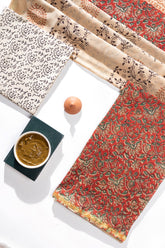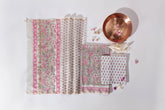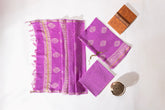The monsoon season brings relief from scorching heat, but it also poses a significant challenge for preserving delicate textiles like silk bandhani dupattas. These intricate tie-dye masterpieces, with their vibrant colors and delicate silk fibers, require special attention during humid weather to maintain their beauty and longevity. Whether you own a precious lagdi patta dupatta or a simple cotton bandhej piece, proper storage during rainy days can mean the difference between preserving a treasured heirloom and watching it deteriorate.
In this comprehensive guide, we'll explore proven DIY methods, natural moisture-control techniques, and expert-recommended storage solutions that will keep your silk bandhani dupatta collection pristine throughout the monsoon season and beyond.
Understanding the Challenges: Why Moisture Damages Silk Bandhani Dupattas
The Science Behind Silk and Humidity
Silk is a natural protein fiber that readily absorbs moisture from the environment. During monsoon season, when humidity levels can soar above 80%, silk bandhani dupattas become particularly vulnerable to several damaging effects:
Color Bleeding and Fading: The traditional vegetable dyes used in authentic bandhani work can become unstable in high humidity, leading to color migration and permanent staining. This is especially problematic with red bandhani dupattas and other vibrant colors.
Mold and Mildew Growth: Excess moisture creates ideal conditions for fungal growth, which can cause permanent discoloration, musty odors, and structural damage to the silk fibers.
Fabric Weakening: Constant exposure to humidity can break down the protein bonds in silk, making the fabric brittle and prone to tearing.
Starch Attraction: The natural starch often used in bandhej dupatta finishing attracts moisture and becomes a breeding ground for bacteria and pests.
Why Traditional Storage Methods Fail
Many traditional storage approaches actually worsen moisture problems during monsoon season. Plastic bags trap humidity, creating a greenhouse effect that accelerates damage. Simple cloth wrapping without proper moisture barriers allows ambient humidity to reach the fabric. Even cedar chests, while protecting against pests, can retain moisture if not properly ventilated.
Essential Pre-Storage Preparation for Silk Bandhani Dupattas
Complete Cleaning Protocol
Before storing any silk bandhani dupatta, thorough cleaning is crucial to remove oils, perfumes, and microscopic debris that can attract moisture and pests.
Hand-Washing Technique:
-
Fill a basin with cool water (below 30°C) and add one teaspoon of pH-neutral wool detergent
-
Gently submerge the dupatta without twisting or wringing
-
Swish gently for 2-3 minutes, paying attention to heavily soiled areas
-
Rinse with cool water until no suds remain
-
Never wring—instead, press gently between clean towels to remove excess water
Spot-Cleaning for Delicate Pieces:
For heavily embellished lagdi patta dupattas or antique pieces, spot-cleaning prevents damage while removing problematic stains:
-
Mix equal parts white vinegar and distilled water
-
Test on an inconspicuous area first
-
Dab gently with a cotton swab
-
Blot with a clean, dry cloth immediately
Strategic Drying Methods
Proper drying before storage is critical for preventing trapped moisture that can cause long-term damage.
Indoor Drying Setup:
Create a dedicated drying area away from direct sunlight and heat sources. Lay the dupatta flat on a clean, absorbent surface such as:
-
Multiple layers of white cotton towels
-
A mesh drying rack covered with muslin cloth
-
A clean, flat sheet stretched between chairs
Accelerated Drying Techniques:
During monsoon season when air-drying is challenging, these methods can help:
-
Use a dehumidifier in the drying room to reduce ambient moisture
-
Position a fan (not directly on the fabric) to improve air circulation
-
Place moisture-absorbing packets nearby (but not touching the fabric)
DIY Moisture-Control Solutions for Silk Bandhani Dupatta Storage
Natural Desiccant Preparations
Creating effective, chemical-free moisture absorbers protects your silk bandhani dupattas without introducing harmful substances.
Activated Charcoal Sachets:
Activated charcoal naturally absorbs excess moisture and odors. Create storage sachets by:
-
Purchasing food-grade activated charcoal (available at health stores)
-
Filling small cotton muslin bags with 2-3 tablespoons of charcoal
-
Securing tightly with natural cotton string
-
Placing 2-3 sachets in each storage container (not in direct contact with fabric)
-
Replacing every 3-4 months for optimal effectiveness
Rice-Based Moisture Absorbers:
Uncooked rice acts as an excellent moisture absorber and is readily available:
-
Fill cotton socks with dry, uncooked rice
-
Tie securely at the opening
-
Place in storage containers, ensuring no direct fabric contact
-
Replace every 2 months during monsoon season
Silica Gel Alternative - Chalk Method:
Regular white chalk (calcium carbonate) absorbs moisture effectively:
-
Collect 8-10 pieces of plain white chalk
-
Bundle together with cotton string
-
Hang in storage areas or place in breathable containers
-
Replace when chalk begins to crumble or becomes soft
Clay Pot Storage System
Traditional clay pots offer excellent moisture regulation for silk bandhani dupatta storage.
Preparation Process:
-
Select unglazed terracotta pots large enough for folded dupattas
-
Clean thoroughly and allow to dry completely
-
Line the bottom with acid-free tissue paper
-
Create a protective barrier using unbleached muslin cloth
Multi-Layer Protection:
-
First layer: Acid-free tissue paper (prevents direct clay contact)
-
Second layer: Clean cotton muslin (allows air circulation)
-
Third layer: Your silk bandhani dupatta, loosely folded
-
Top layer: Another muslin cover
-
Final protection: Clay pot lid (slightly ajar for air circulation)
This system naturally regulates humidity while protecting against pests and dust.
Professional-Grade Storage Techniques
Archive-Quality Boxing Method
Museum-standard storage techniques can be adapted for home use to provide superior protection for valuable silk bandhani dupattas.
Materials Needed:
-
Acid-free cardboard boxes (available online or at art supply stores)
-
Unbuffered tissue paper
-
Cotton muslin cloth
-
Natural lavender sachets
-
Moisture indicator cards
Step-by-Step Process:
-
Line the box bottom with unbuffered tissue paper
-
Lay a sheet of pre-washed cotton muslin over the tissue
-
Place the dupatta face-down on the muslin
-
Cover with another layer of muslin
-
Add a final layer of tissue paper
-
Include one moisture indicator card to monitor humidity levels
-
Close the box, leaving a small gap for air circulation
Climate-Controlled Cabinet Setup
For extensive collections, creating a dedicated storage cabinet provides optimal protection.
Cabinet Preparation:
-
Choose a wooden cabinet (avoid metal, which can cause condensation)
-
Install a small hygrometer to monitor humidity levels
-
Add ventilation holes covered with fine mesh to prevent pests
-
Line shelves with cedar paper (natural pest deterrent)
Optimal Storage Conditions:
-
Temperature: 65-70°F (18-21°C)
-
Humidity: 45-55% relative humidity
-
Air circulation: Gentle, consistent movement
-
Light exposure: Complete darkness when stored
Seasonal Storage Strategies
Pre-Monsoon Preparation (April-May)
Deep Cleaning Schedule:
-
April: Begin with spot-cleaning any visible stains
-
Early May: Complete hand-washing of all dupattas
-
Mid-May: Ensure complete drying and begin storage preparation
Inventory and Assessment:
Create a detailed inventory of your silk bandhani dupatta collection:
-
Photograph each piece for identification
-
Note any existing damage or weak areas
-
Prioritize most valuable pieces for premium storage methods
-
Identify pieces needing repair before storage
During Monsoon Management (June-September)
Weekly Monitoring Routine:
-
Check moisture indicator cards in storage containers
-
Inspect for any signs of pest activity
-
Ensure desiccant sachets remain effective
-
Verify storage area temperature and humidity levels
Emergency Response Protocol:
If you discover moisture infiltration:
-
Remove affected dupattas immediately
-
Allow complete air-drying in a controlled environment
-
Assess for any damage or staining
-
Replace all moisture-absorbing materials
-
Improve storage container sealing
Post-Monsoon Assessment (October)
Condition Evaluation:
Carefully examine each stored dupatta for:
-
Color integrity and any fading
-
Fabric strength and flexibility
-
Presence of any musty odors
-
Signs of pest damage
Maintenance Actions:
-
Re-fold along different lines to prevent permanent creases
-
Replace all moisture-absorbing materials with fresh supplies
-
Clean storage containers thoroughly
-
Update inventory with any condition changes
Advanced Preservation Techniques
Natural Pest Deterrent Systems
Protecting silk bandhani dupattas from insects requires natural, fabric-safe approaches.
Neem Leaf Method:
Dried neem leaves provide excellent protection against moths and other textile pests:
-
Collect fresh neem leaves during dry weather
-
Air-dry completely until brittle
-
Crush lightly to release natural oils
-
Place in small muslin pouches
-
Position around storage areas (not in direct contact with silk)
Cedar and Lavender Combination:
This dual-action approach repels pests while providing a pleasant, natural fragrance:
-
Combine cedar shavings with dried lavender flowers
-
Create sachets using breathable cotton fabric
-
Replace every 6 months for continued effectiveness
-
Avoid direct contact with silk to prevent oil staining
Temperature Shock Treatment
For suspected pest infestations, controlled temperature treatment can eliminate insects without chemical damage.
Freezer Method (for small pieces):
-
Seal the dupatta in a plastic bag with minimal air
-
Place in freezer for 72 hours at 0°F (-18°C)
-
Allow gradual return to room temperature before unpacking
-
This kills all life stages of common textile pests
Heat Treatment (professional option):
For valuable pieces, professional heat treatment at 140°F (60°C) for 4-6 hours eliminates pests while preserving fabric integrity.
Troubleshooting Common Storage Problems
Yellowing and Discoloration Issues
Causes and Prevention:
Yellowing in silk bandhani dupattas typically results from:
-
Exposure to artificial light during storage
-
Chemical reactions with improper storage materials
-
Natural aging of protein fibers
-
Residual detergent or cleaning products
Correction Methods:
-
Mild Yellowing: Gentle washing with oxygen-based bleach alternative
-
Localized Stains: Spot treatment with lemon juice and salt paste
-
Overall Dullness: Professional restoration consultation
Persistent Musty Odors
Immediate Response:
-
Remove from storage immediately
-
Air in well-ventilated, dry area for 24-48 hours
-
Check for visible mold or mildew spots
-
If clean, the odor likely comes from storage materials
Long-term Solutions:
-
Replace all organic storage materials (cotton, paper)
-
Improve storage area ventilation
-
Consider switching to synthetic, mold-resistant storage options
-
Add activated charcoal permanently to storage system
Fabric Stiffness and Brittleness
Restoration Techniques:
-
Gentle Steam Treatment: Hold dupatta near (not in) steam from a kettle
-
Humidity Conditioning: Gradually expose to controlled humidity levels
-
Professional Consultation: For valuable pieces showing significant deterioration
Storage Solutions by Dupatta Type
Heavy Bandhani Dupattas with Embellishments
These require special handling due to their weight and decorative elements:
Flat Storage Method:
-
Use large, shallow drawers lined with acid-free materials
-
Support embellished areas with tissue paper padding
-
Never fold along embellished sections
-
Cover with breathable cotton sheeting
Rolling Technique for Long-term Storage:
-
Cover a large tube (4-inch diameter minimum) with muslin
-
Lay dupatta face-down on a clean surface
-
Place the covered tube at one end
-
Roll slowly, adding tissue paper layers as you progress
-
Secure with cotton ties (never rubber bands or clips)
Delicate Silk Bandhej Pieces
Tissue Paper Layering:
-
Use only unbuffered, acid-free tissue paper
-
Create multiple layers between folds
-
Support all fold lines to prevent permanent creasing
-
Store in rigid containers to prevent crushing
Daily-Wear Cotton Bandhani Dupattas
Simplified Storage Approach:
-
Clean cotton storage bags work well for regular-use pieces
-
Ensure complete drying before storage
-
Basic moisture control (rice sachets) provides adequate protection
-
Can tolerate more flexible storage conditions
Innovative DIY Storage Hacks
Vacuum Storage Modification
Traditional vacuum storage can damage delicate silk, but a modified approach works well:
Gentle Vacuum Method:
-
Place dupatta in vacuum bag with tissue paper buffers
-
Remove only 50% of air (not complete vacuum)
-
This reduces space while maintaining some cushioning
-
Monitor regularly and re-fluff if compression is excessive
Breathable Garment Bag System
Creating Custom Storage Bags:
-
Use unbleached cotton fabric to sew fitted storage bags
-
Add drawstring closures for easy access
-
Include small pockets for desiccant sachets
-
Label clearly for easy identification
Modular Storage Tower
Building a Custom System:
-
Stack uniform-sized boxes or containers
-
Connect with ventilation tubes for air circulation
-
Add removable trays for easy access
-
Include integrated moisture monitoring
Monsoon-Specific Regional Adaptations
Coastal Areas (High Salt Air)
Additional Protections Needed:
-
Salt-resistant storage materials
-
Extra moisture control measures
-
Regular cleaning to remove salt deposits
-
Enhanced ventilation systems
Mountain Regions (Temperature Fluctuations)
Stability Measures:
-
Insulated storage areas
-
Consistent temperature monitoring
-
Gradual acclimatization when removing from storage
-
Flexible moisture control that adapts to temperature changes
Urban Environments (Pollution Concerns)
Filtration Approaches:
-
Air purification in storage areas
-
Regular cleaning of storage containers
-
Protection from dust and particulates
-
Enhanced sealing systems
Long-Term Preservation Planning
5-Year Storage Rotation
Systematic Approach:
-
Year 1-2: Primary storage with premium materials
-
Year 3: Mid-term assessment and material refresh
-
Year 4-5: Deep evaluation and potential restoration
-
Reset cycle with updated techniques and materials
Heritage Piece Documentation
Creating Preservation Records:
-
Detailed photographic documentation
-
Storage method notes and material lists
-
Condition assessment timeline
-
Repair and maintenance history
Investment in Professional Tools
Gradual Equipment Upgrade:
-
Start with basic moisture meters and indicators
-
Add professional-grade storage materials over time
-
Consider climate control equipment for extensive collections
-
Build relationships with textile conservation professionals
Emergency Response and Disaster Recovery
Water Damage Protocol
Immediate Actions (First 24 Hours):
-
Remove from wet storage immediately
-
Separate layers to prevent color transfer
-
Lay flat on absorbent, white towels
-
Change towels frequently as they become saturated
-
Contact professional textile conservator if damage is extensive
Recovery Techniques:
-
Never attempt to accelerate drying with heat
-
Maintain air circulation without direct airflow on fabric
-
Monitor for mold development during drying process
-
Document damage for insurance purposes if applicable
Pest Infestation Response
Assessment and Action:
-
Identify pest type and extent of infestation
-
Isolate affected pieces immediately
-
Implement appropriate treatment (freezing, heat, or professional service)
-
Deep clean all storage areas and containers
-
Upgrade pest prevention measures before returning items to storage
Frequently Asked Questions
Q: How often should I check on stored silk bandhani dupattas during monsoon season?
A: During active monsoon months, inspect your storage system weekly. Check moisture indicators, look for any signs of pest activity, and ensure desiccant materials are still effective. Between monsoons, monthly checks are sufficient.
Q: Can I use regular plastic containers for storing silk bandhani dupattas?
A: Regular plastic containers are not recommended for long-term storage as they don't allow air circulation and can trap moisture. If you must use plastic, choose containers with ventilation holes and never seal completely. Food-grade containers are preferable to prevent chemical leaching.
Q: What's the difference between storing a silk bandhani dupatta versus a cotton one?
A: Silk requires more stringent moisture control and temperature stability. Cotton bandhani dupattas are more forgiving but still benefit from proper storage techniques. Silk is more susceptible to permanent damage from humidity and requires acid-free storage materials.
Q: How do I know if my stored dupatta has been damaged by moisture?
A: Warning signs include musty odors, visible mold spots, color bleeding, fabric stiffness, or a chalky residue on the surface. If you notice any of these signs, remove the dupatta from storage immediately and assess the damage.
Q: Is it safe to store multiple bandhani dupattas together?
A: Yes, but with precautions. Separate different colors with acid-free tissue paper to prevent color transfer. Ensure all pieces are completely clean and dry before storage. Don't overcrowd containers, as this can prevent proper air circulation.
Q: What should I do if I find small holes in my stored silk bandhani dupatta?
A: Small holes typically indicate pest damage, particularly from moths or carpet beetles. Remove all items from storage immediately, inspect for live insects, and treat the area with appropriate pest control measures. Damaged dupattas may require professional restoration.
Q: Can I store silk bandhani dupattas in the same area as other textiles?
A: Yes, but ensure all textiles are properly cleaned and stored using appropriate methods. Different fabrics may require different storage conditions, so monitor the environment carefully to meet all needs.
Q: How long can I safely store a silk bandhani dupatta using these methods?
A: With proper storage techniques and regular monitoring, silk bandhani dupattas can be safely stored for many years. Some museum pieces have been preserved for decades using similar methods. The key is consistent care and appropriate environmental conditions.
Conclusion: Preserving Your Silk Bandhani Heritage
Proper storage of silk bandhani dupattas during monsoon season requires attention to detail, but the investment in time and materials pays dividends in preserving these beautiful textile treasures. By implementing the DIY moisture-free storage techniques outlined in this guide, you can protect your collection from the damaging effects of humidity while maintaining the vibrant colors and delicate craftsmanship that make each piece special.
Remember that every silk bandhani dupatta tells a story of traditional craftsmanship passed down through generations. Whether you're caring for a simple everyday piece or a precious lagdi patta dupatta with intricate zari work, these storage methods ensure that story continues for years to come.
The key to successful long-term preservation lies in consistency, monitoring, and adapting your approach based on your specific environment and collection needs. Start with the basic techniques outlined here, and gradually incorporate more advanced methods as you gain experience and expand your collection.
Your silk bandhani dupattas represent more than just beautiful textiles—they're connections to India's rich cultural heritage and the skilled artisans who created them. By taking proper care during storage, especially during challenging monsoon seasons, you're not just preserving fabric; you're preserving history, artistry, and tradition for future generations to appreciate and enjoy.
For authentic silk bandhani dupattas and expert care products, explore the curated collection at Vastraraag, where traditional craftsmanship meets contemporary quality standards.









